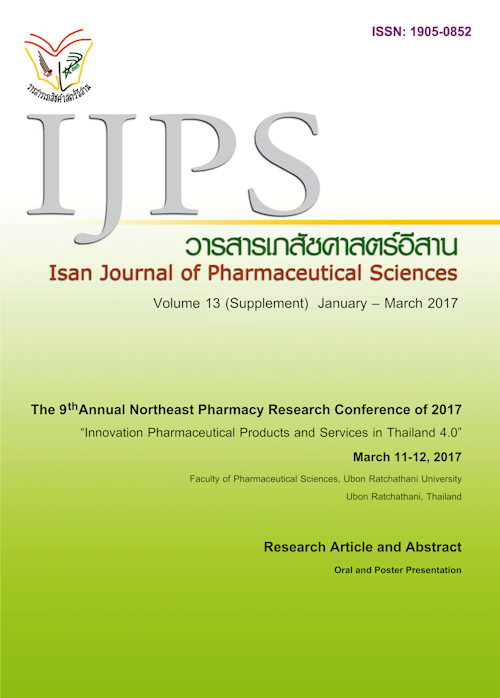Healthcare providers and patient or caregiverOs perspective on patients with re-visit asthma exacerbation
Main Article Content
Abstract
Introduction: Asthma exacerbation is a condition that requires hospitalization visit oremergency department(ED). In Thailand, 15 percent of patients with asthma exacerbation were hospitalized and another 21 percent of these patients had visited an emergency department for treatment with inhalation.This results in alteration of patientcs quality of life. Therefore, asthma exacerbation-related factors are important and should be studied especially in healthcare provider and re-visit asthma patients perspectives in order to improve management of asthma in Thai patients. Objective: To explore healthcare providersand patient or caregivercs perspective on patients with asthma exacerbation. Methods: This is a qualitative descriptive study by in-depth interview. The 12 healthcare providers and 30 patients or caregivers who requiring emergency department visit at least 2 timeswith asthma exacerbationwere interviewed with sound record for 30 minute each. Interview was analyzed by content analysis method to determine healthcare providersand patients or caregivers point of view on causes of asthma exacerbation. Results: Data from the in depth interview showed that the major problems of asthma exacerbation from healthcare providerscperspectives were under diagnosis or a delay of diagnosis leading to a delay of treatment with inhaled corticosteroid. Causes ofproblems were outdated in treatment guideline, less detail provided in the guideline, healthcare provider team did not follow standard guideline, ineffective referral system for asthma patients in terms of patient information, and lack of holistic care. Other factors were inappropriate use of medication and presence of allergen. From perspectives of patient and caregiver, most common causes were weather change, no emergency bronchodilator supplies, missing appointments, self-medication use as well as incorrect technique of inhaler use. Conclusion: The major cause of asthma exacerbation was the problem with treatment guideline. Therefore, guideline development should be structured and reviewed to overcome these problems as it will be the most benefit to our patients.
Article Details
In the case that some parts are used by others The author must Confirm that obtaining permission to use some of the original authors. And must attach evidence That the permission has been included
References
Atchawaponpisan P, Chantarawong J, Pitakkitronnakon W. The Effect of an Education Program on Knowledge and Preventive Behavior for Mother of Children Asthma Phrae hospital. Journal of the Phrae hospital. 2012.
Blais L, Suissa S, Boivin J, et al. First treatment with inhaled corticosteroids and the prevention of admissions to hospital for asthma. Thorax1998; 53:1025-1029.
Chayakul C, Chongtrakul P, Wananukul W, et al, editors. Rational Drug Use Hospital Manual. Bangkok: Co-opthai publisher; 2015.
Dangsuwan T. Childhoodasthma. Journal of the department of medical services 2016. May-Aug; 41(4).
Geyser MM, Rheeder P. Risk factor precipitating exacerbations in adult asthma patients at Kalafong hospital, Pretoria. SA FamPract2008; 50:67-67e.
Giraud V, Nicolas R, and Allaert F. Inhaler technique and asthma: Feasibility and acceptability of training by pharmacists. Resp med. 2011.
Jahdali H, Ahmed A, Harbi A, et al. Improper inhaler technique is associated with poor asthma control and frequent emergency department visits. AACI 2013; 9(1):8.
Kanitsup A, Wangweerawong M. Diagnosis and treatment of asthma in Thailand. Bangkok: Thai asthma council; 2012.
Lynch B, VanNorman C, Jacobson R, Weaver A, John Y. Impact of delay in asthma diagnosis on health care service use. Allergy asthma proc. 2010.
Mehuys E, Bortel L, Bolle L, et al. Effectiveness of pharmacist intervention for asthma control improvement. Eur Respir J 2008; 31: 790-799.
Mekasuwanadit S. Effect of medical education for asthma patient: case report Ongkalukhospital. Thai Pharmaceutical and health Science Journal 2008;3.
Rastogi D, Madhok N, Kipperman S. Caregiver Asthma Knowledge, Aptitude and practice in high healthcare Utilizing Children: Effect of an Educational Intervention. Pediatrallergy, immunolpulmonol 2013; 26(3): 128-139.
Srisupa R. The study recurrent asthmatic attack patients in Khamcha-I hospital. Journal of the office of ODPC 7 Khonkaen. 2012.
Srisuwan P, Koopitakkajorn T, Kingkaew P, et al. The recommendations of population-based screening guideline for asthma. Health systems research institute 2013; 462-7.
Tarlo S, Broder I, Corey P, et al. A case-control study of the role of cold symptoms and other historical triggering factors in asthma exacerbations. Can Respir J2000; 7:42-48.
Taylor D, Auble T, Calhoun W, Mosesso V. Current outpatient management of asthma shows poor compliance with international consensus guidelines. Chest 1999; 1638-1645.
Toshikazu A, Yasuharu T, Sachiko O, et al. The relationship of short term air pollution and weather to ED visit for asthma in Japan. Am JEmerg Med 2009; 27: 153-15.
Watase H, Yusuke H, Takuyo C, Camargo C, Hasekawa K. Multicenter observational study of adults with asthma exacerbation: who are the frequent users of the emergency department in Japan. BMJ 2014.
Williams K, Peterson E, Wells K, et al. Quantifying the proportion of severe asthma exacerbations attributable to inhaled corticosteroid nonadherence. JAllergy, ClinImmunol 2011; 128(6): 1185-1191.
Yimleang S, Rattanawichai P, Jakwichien C. Improvement of a Continuing Care Model in pediatric asthma. Journal nursing divisions. 2009; 96-111.


